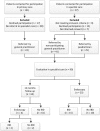Diagnostic test strategies in children at increased risk of inflammatory bowel disease in primary care
- PMID: 29211800
- PMCID: PMC5718464
- DOI: 10.1371/journal.pone.0189111
Diagnostic test strategies in children at increased risk of inflammatory bowel disease in primary care
Abstract
Background: In children with symptoms suggestive of inflammatory bowel disease (IBD) who present in primary care, the optimal test strategy for identifying those who require specialist care is unclear. We evaluated the following three test strategies to determine which was optimal for referring children with suspected IBD to specialist care: 1) alarm symptoms alone, 2) alarm symptoms plus c-reactive protein, and 3) alarm symptoms plus fecal calprotectin.
Methods: A prospective cohort study was conducted, including children with chronic gastrointestinal symptoms referred to pediatric gastroenterology. Outcome was defined as IBD confirmed by endoscopy, or IBD ruled out by either endoscopy or unremarkable clinical 12 month follow-up with no indication for endoscopy. Test strategy probabilities were generated by logistic regression analyses and compared by area under the receiver operating characteristic curves (AUC) and decision curves.
Results: We included 90 children, of whom 17 (19%) had IBD (n = 65 from primary care physicians, n = 25 from general pediatricians). Adding fecal calprotectin to alarm symptoms increased the AUC significantly from 0.80 (0.67-0.92) to 0.97 (0.93-1.00), but adding c-reactive protein to alarm symptoms did not increase the AUC significantly (p > 0.05). Decision curves confirmed these patterns, showing that alarm symptoms combined with fecal calprotectin produced the diagnostic test strategy with the highest net benefit at reasonable threshold probabilities.
Conclusion: In primary care, when children are identified as being at high risk for IBD, adding fecal calprotectin testing to alarm symptoms was the optimal strategy for improving risk stratification.
Conflict of interest statement
Figures


References
-
- Peery AF, Dellon ES, Lund J, Crockett SD, McGowan CE, Bulsiewicz WJ, et al. Burden of gastrointestinal disease in the United States: 2012 update. Gastroenterology 2012;143(5):1179–1187.e3. doi: 10.1053/j.gastro.2012.08.002 - DOI - PMC - PubMed
-
- Gieteling MJ, Lisman-van Leeuwen Y, van der Wouden JC, Schellevis FG, Berger MY. Childhood nonspecific abdominal pain in family practice: incidence, associated factors, and management. Ann Fam Med 2011. Jul-Aug;9(4):337–343. doi: 10.1370/afm.1268 - DOI - PMC - PubMed
-
- BEACH Program, AIHW General Practice Statistics and Classification Unit. Presentations of abdominal pain in Australian general practice. Aust Fam Physician 2004. December;33(12):968–969. - PubMed
-
- Spee LA, Lisman-Van Leeuwen Y, Benninga MA, Bierma-Zeinstra SM, Berger MY. Prevalence, characteristics, and management of childhood functional abdominal pain in general practice. Scand J Prim Health Care 2013;31(4):197–202. doi: 10.3109/02813432.2013.844405 - DOI - PMC - PubMed
-
- Kokkonen J, Haapalahti M, Tikkanen S, Karttunen R, Savilahti E. Gastrointestinal complaints and diagnosis in children: a population-based study. Acta Paediatrica 2004;93(7):880–886. - PubMed
MeSH terms
Substances
LinkOut - more resources
Full Text Sources
Other Literature Sources
Research Materials

